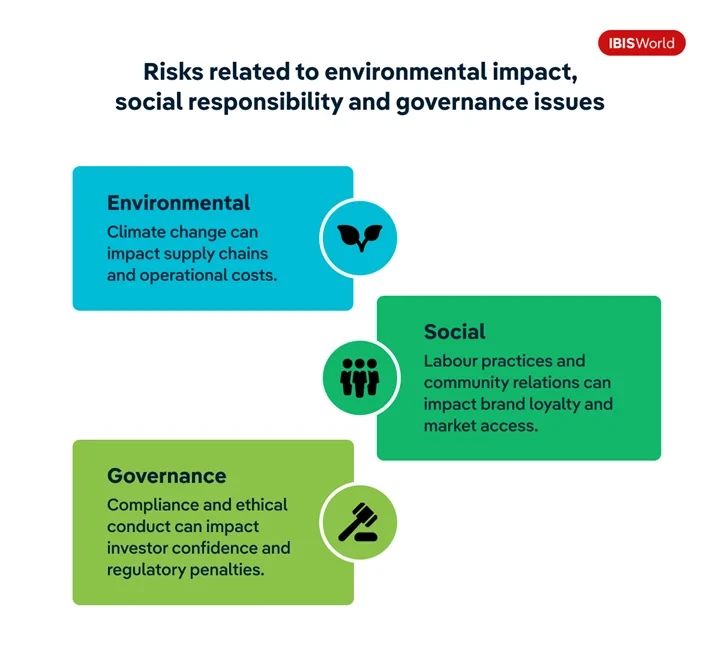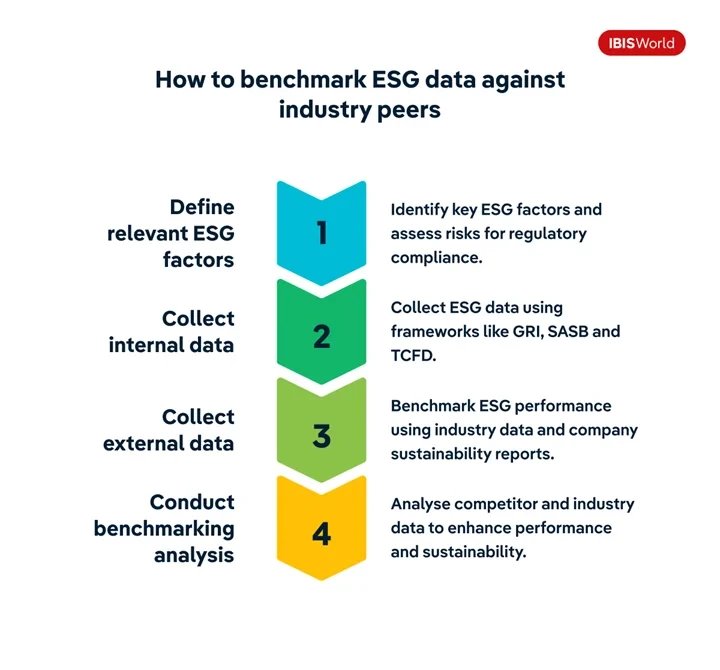Key takeaways:
Australia’s new Mandatory Climate-Related Financial Disclosure regulations mark a shift towards compulsory sustainability reporting, improving transparency and accountability.
The lack of standardised ESG frameworks has led to inconsistent data and greenwashing, but increasing regulatory mandates are improving data accuracy and availability.
Effective ESG data utilisation and benchmarking are essential for identifying performance indicators, transition risks and strategic opportunities, guiding businesses towards sustainability.
The rise of Environmental, Social and Governance (ESG) in recent years has been meteoric. Once dismissed by many as just a corporate buzzword, ESG has proven it’s here to stay. This is especially evident with Australia’s proposed new Mandatory Climate-Related Financial Disclosure regulations, beginning an era of mandatory sustainability reporting.
With compulsory reporting comes a wealth of non-financial information for data enthusiasts like me to analyse. Having worked on ESG data for the past two years, I have experienced similar frustrations to others when collecting and analysing ESG data. The lack of an agreed-upon ESG framework in Australia and internationally has led to widespread greenwashing and fragmented reporting frameworks. There is a lot of noise surrounding ESG, and it’s no surprise that many people are struggling to make sense of it all.
Finding valuable insights from the murky waters of ESG data can aid in effective decision-making, as it reveals performance indicators, identifies transition risks and opportunities and allows businesses to benchmark against national and industry standards. Determining how your company ranks among its peers is vital for informing strategic decisions.
Relevant data can also empower companies to pinpoint key issues, analyse current and past performance, set goals and allocate resources more effectively. As pressure from regulators, investors and the public intensifies, prioritising ESG data has become more important than ever.
The state of ESG data
Compiling accurate and trustworthy ESG data has been a significant challenge for me, as it is for many ESG analysts. The lack of mandatory standardised reporting frameworks has led to fragmented and inconsistent data, exacerbating issues like greenwashing.

As the renowned British economist Ronald Coase once said, ‘If you torture the data long enough, it will confess to anything.’ Without stringent reporting standards, companies can manipulate the ESG data to present the narrative they desire. Due to the patchy and inconsistent nature, ESG analysts must be creative in their data collection and analysis methods and wary of inaccurate or unreliable sources.
However, the landscape is improving as ESG data accuracy and availability are being enhanced through increased regulatory mandates and harmonised frameworks. Regulators are demanding more standardised data from companies to enhance transparency and accountability.
For example, changes to the Workplace Gender Equality Act 2012 now require employers with 100 or more employees to report their gender pay gaps to the Workplace Gender Equality Agency (WGEA). The standardised data collection and reporting methods implemented by the WGEA prevent companies from cherry-picking favourable metrics. Previously, companies could report pay gaps in various ways—like-for-like pay gaps, base salary gaps, total remuneration gaps, by median or mean—choosing whichever metric presented them in the best light. Consistent mandatory reporting not only increases the volume of available data, but also makes comparing and aggregating this data a much more fruitful endeavour. These changes in reporting standards reflect a broader trend towards increased transparency and accountability.

The introduction of mandatory climate-related financial disclosures
A recent significant development in ESG is the change in Australia’s financial reporting framework, marked by the introduction of the first draft of the Treasury Laws Amendment (Financial Market Infrastructure and Other Measures) Bill 2024. For the first time, this Bill will mandate climate-related financial disclosures for businesses, including large entities and asset owners, in accordance with sustainability standards set by the AASB.
The implementation is planned to be phased over the next few years, beginning with a small group of very large entities and gradually expanding to other large entities. The first group is expected to start mandatory reporting from financial years beginning on or after January 1, 2025. These entities will be required to include a new ‘sustainability report’ within the existing annual financial reporting framework. They must disclose information about climate-related financial risks and opportunities, greenhouse gas emissions and governance processes.
As a data analyst, I see this as a fundamental moment. The ability to easily report on climate-related risks and opportunities will offer invaluable insights into an organisation’s long-term sustainability. From my experience, integrating these disclosures will enhance transparency and drive strategic decisions that align with global sustainability goals. But getting a handle on ESG data is going to be crucial for meeting these new requirements.
Understanding ESG data
ESG data can come in various forms, from subjective risk scores to hard numbers that you can benchmark. It can zoom in on a single entity or take a bird’s-eye view of an entire industry, or even the overall economy. In my role, I spend a lot of time digging through company sustainability reports, regulatory documents and data from government departments and organisations. Each type of data has its own role, and using the right data for the right purpose is key.
ESG data helps assess environmental impact, social responsibility and governance practices. Environmental factors like greenhouse gas emissions, energy efficiency, water efficiency and waste management are relatively straightforward to quantify and have been the main focus of recent regulatory and mandatory reporting changes.
But we can’t ignore social responsibility metrics, like workforce composition, First Nations participation and pay equality—they’re just as important. Governance practices, including board diversity, executive compensation and corporate ethics, also play an important role in a comprehensive ESG assessment.

Stakeholder pressures
With pressure mounting from all angles, ESG has become a top priority for many businesses. Stakeholders, including regulators, investors and consumers, have vested interests in holding companies accountable for their ESG reporting and strategies. While new mandatory requirements will directly impact the processes of businesses that fall under the legislation’s scope, they will also provide these stakeholders with reliable and standardised data relating to sustainability and its links to financial risks.
The comparable data which companies will now have to provide will empower stakeholders to compare ESG performance and strategies across the board. This transparency will significantly affect business operations, enabling stakeholders to incorporate this data into their decision-making processes.
Regulator pressure
With escalating regulatory requirements, businesses must ensure compliance to avoid penalties and unwanted scrutiny. It is essential to adhere to current regulations as well as assess the risk of future non-compliance. Staying compliant is a must, but being proactive about potential new regulations is equally as important.
Investor pressure
Investors are even more demanding when it comes to ESG standards. They are increasingly prioritising ESG criteria in their investment decisions, favouring companies with transparent reporting and strong ESG performance. Beyond merely succumbing to regulatory and investor pressures, proactively developing strong ESG strategies enables companies to be on the front foot compared to their competitors.
Consumer pressure
Consumers today are highly aware of the environmental and social impacts of their purchasing decisions. They tend to favour businesses that prioritise sustainability and social responsibility. On the flip side, information spreads quickly in our digital age, and a business’s reputation can be damaged in hours, making risk mitigation essential.
Future-proofing
The potential risks of falling behind are significant, but so are the opportunities for those who lead the way. As Australian businesses increasingly integrate climate-related data, they can also reap benefits in other areas. Effective ESG strategies can lead to more efficient resource use, cost savings and innovation, providing a competitive edge in the industry.
Even companies not yet impacted by these regulations should avoid complacency. Taking proactive measures now can shield businesses from future disruptions and earn favour with regulators and stakeholders. Developing compliance strategies early allows companies to identify risk areas and develop strategies to stay ahead of potential new regulations that could otherwise disrupt operations.
Benchmarking against industry peers
As with all data, ESG numbers don’t mean much without context. Benchmarking is one of the best ways to contextualise a company’s ESG data. It provides a quantifiable and, therefore, more measurable metric for performance.
Although benchmarking is a long-standing corporate strategy, its application in the ESG space is still developing. However, as ESG data continues to grow, ESG benchmarking is becoming increasingly popular. If done well, ESG benchmarking can help businesses accurately assess and improve their ESG performance.
ESG benchmarking involves comparing a company’s ESG performance against its competitors or industry standards. This enables data analysts to extract insights based on how well it performs comparatively. It offers context on a company’s ESG performance, strategies and goals by systematically analysing ESG data. This enables businesses to make more informed ESG strategy decisions, improve stakeholder communication regarding ESG performance and manage ESG risks more effectively.
Here’s a guide to each step:
1. Define what ESG factors are most relevant for your business: Start by identifying the ESG factors that are most pertinent to your industry and specific business operations. Standard materiality assessment methods include engaging stakeholders and reviewing existing reporting frameworks. Industry ESG risk scores can assist in quickly identifying the issues that businesses carry the most significant risk of possible regulatory compliance issues, damage to reputation and scrutiny from investors.
2. Collect internal data: Gather relevant data from your company that reflects your current and past ESG performance. This could include metrics on energy usage, waste production, employee demographics, labour practices, governance policies and other operational aspects. Existing reporting frameworks, such as the Global Reporting Initiative (GRI), the Sustainability Accounting Standards Board (SASB) or the Task Force on Climate-Related Financial Disclosures (TCFD), are useful frameworks to guide your data collection efforts.
3. Collect external data: Obtain data from external sources to benchmark your performance against industry peers and best practices. External resources can provide analysis regarding the ESG practices for major industry operators, as well as industry benchmarking data, such as emissions intensity, energy consumption, water use, First Nations status of industry participants, average total remuneration pay gap, percentage of female employees and weeks of employer-funded paid parental leave. While more time-consuming due to requiring a higher level of data-scraping, company sustainability reports can be beneficial for more targeted analysis and comparison.
4. Conduct benchmarking analysis: Analyse data from competitors, industry leaders and industry averages to identify where your business stands relative to others. External data provides context and can identify areas where your business can improve its performance or leverage its strengths. Industry trends over the past few years can also provide valuable information as to how industry peers are progressing towards their sustainability efforts.

How to use ESG benchmarking for strategic planning
Benchmarking and incorporating ESG data sooner rather than later allow you to uncover potential risks related to environmental impact, social responsibility and governance issues, ensuring your business is well-prepared for the future. By understanding these risks, companies can mitigate adverse effects on operations, enhance their reputation and build resilience against future regulatory changes.
Environmental risks, like those related to climate change, can impact supply chains and operational costs. Social risks, including labour practices and community relations, can impact brand loyalty and market access. Governance risks, such as compliance and ethical conduct, can influence investor confidence and regulatory penalties. Therefore, integrating ESG data ensures compliance and supports long-term sustainability and competitiveness in the market, making it crucial for businesses to address these areas proactively.
It doesn’t matter how much data you have; what counts is how effectively you use it. ESG benchmarking analysis, when done well, can be used to formulate ESG strategies by addressing identified gaps and leveraging strengths. Analysing ESG performance will help identify the critical areas for improvement in a company’s ESG plan.
Strategy and goals should be focused on these areas of weakness to improve outcomes. Goals and strategy should be, at a minimum, up to date with industry best practices, which can be extracted from sustainability reporting. When setting goals, aligning them to metrics collected and analysed in the benchmarking process will set up the company to measure the effectiveness of future strategies.
Continuous monitoring and adoption
The old adage that, ‘if you’re not moving forward, you’re moving backwards’, has never been more relevant. Continued progress in monitoring and reviewing strategies and goals are a necessity. Establishing a system for regularly tracking and reviewing your ESG performance against your benchmarks and goals will ensure continued progress.
This can be done by conducting periodic reviews to assess the effectiveness of your strategies and making necessary adjustments. Stay informed about changes in regulations, industry trends and stakeholder expectations to keep your strategy relevant.
The volume of ESG data is skyrocketing. In my relatively short time collecting and analysing industry ESG data, I have seen first-hand the rapid influx of industry data related to environmental and social issues. The growth of company data has expanded even more rapidly with the evolution of sustainability reporting. Continuous improvement is vital, so be prepared to iterate on your strategies as new data and insights become available.
Final thoughts
ESG is transforming modern business, driven by increasing regulatory demands and stakeholder expectations. Australia’s new Mandatory Climate-Related Financial Disclosure regulations are a prime example of this shift, mandating sustainability reporting and generating valuable non-financial data. From my perspective, effective ESG data utilisation is central to surviving and thriving in the shifting landscape.
One powerful method for making sense of ESG data is benchmarking. By identifying key performance areas and comparing them against industry standards, businesses can set clear, data-driven goals. Regularly tracking and reviewing ESG performance ensures continuous improvement and compliance with evolving regulations.
One of the most rewarding aspects of my work is seeing how data can create actionable insights that guide strategic decisions. The more we integrate ESG principles into our business practices, the more we can contribute to a sustainable future while staying ahead in a competitive market. It’s an exciting time to be at the intersection of data analysis and sustainability, where every dataset can make a significant impact.
As ESG becomes a foundation of business strategy, companies prioritising strong ESG practices will be better positioned to steer through the complexities of the modern market and secure their future success.
Source from IBISWorld
Disclaimer: The information set forth above is provided by ibisworld.com independently of Chovm.com. Chovm.com makes no representation and warranties as to the quality and reliability of the seller and products.



